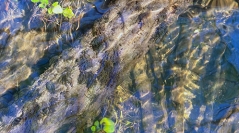

 Cryptogamie, Algologie
45 (5) - Pages 53-62
Cryptogamie, Algologie
45 (5) - Pages 53-62Haploid-diploid life cycles impose unique eco-evolutionary consequences, rendering commonly used proxies difficult to use (e.g. separate sexes prevent selfing). Population genetic analyses are therefore required to explore patterns of reproductive system variation. However, there are still few haploid-diploid species for which polymorphic, nuclear loci exist. This problem is particularly acute for algae. Here, we describe the development of the first microsatellite loci in a freshwater red alga. We tested 73 candidate loci against a panel of Batrachospermum gelatinosum (L.) De Candolle gametophytes that encompass much of its North American range. Ten loci consistently amplified and were characterized by clean peak architectures on a capillary sequencer with one allele per locus, as expected in a haploid gametophyte. We then explored some basic population genetic indices in gametophytes collected from one site and obtained good resolution based on the probability of identity (pid). Yet, we observed a pattern of clumped repeated genotypes throughout the stream reach sampled. The pattern of moderate genotypic richness could be due to intragametophytic selfing resulting in the complete loss of genetic diversity from a single gamete union. Future studies will need to sample more populations to determine if intragametophytic selfing is the dominant reproductive mode in this monoicous taxon. The loci developed here represent an important tool for studying freshwater red algal populations in specific as well as enhancing our understanding of reproductive system variation and the haploid-diploid life cycle of algae in general.
North America, Rhodophyta, haploid-diploid life cycle, locus development, partial clonality, primers, population genetics